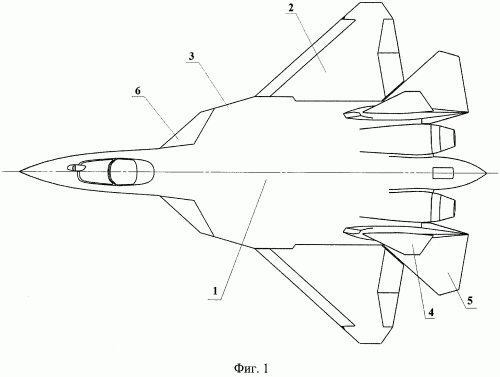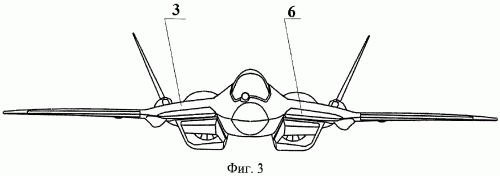saintkatanalegacy
Little Miss Whiffologist
- Joined
- 31 March 2009
- Messages
- 718
- Reaction score
- 9
Maneuverable aircraft: http://www.findpatent.ru/patent/250/2503584.html
The invention relates to aviation and the concerns maneuverable aircraft systems and their management. Maneuverable aircraft comprises a fuselage, swept wing, front swept nodules, controls, chassis. Front nodules located at the junction of the head and middle portions of the fuselage and equipped with controlled rotary surfaces. The axes of the steering surfaces arranged perpendicularly or sagging under an angle to the longitudinal plane of the aircraft. Achieved by enhancing the safety and combat effectiveness of the aircraft by increasing stocks diving moment and thus extend the range of allowable center of gravity and increase the resources of the combat equipment of the aircraft, the implementation of the best combination of lift and drag. 3 ill.
The invention relates to aviation, namely maneuverable aircraft systems and their control of the aircraft. Known maneuverable plane containing the fuselage, swept wing of moderate sweep, sweep large influxes front, controls, chassis (RU, 2302975 C2). Known aircraft has high lifting properties at subsonic and supersonic regimes. At supersonic speeds front sags significantly shift the focus of the aircraft forward, thereby providing a reduction in the stock of the static stability of the aircraft, which in turn, reduces the loss of aerodynamic performance for balancing increases the maneuverability of the aircraft. As disadvantages of the aircraft should indicate the following. At supercritical angles of attack, when to end the wing stall occurs, the front nodules continue to create the lift force, creating time to pitch, resulting in a decrease in disposable moment to dive, and for aircraft with a full set of external load, even to his absence (for maximum rearward center of gravity).
Technical result, The aim of the invention is to improve safety and combat effectiveness of the aircraft by increasing stocks diving moment and thus extend the range of allowable center of gravity and increase the resources of the combat equipment of the aircraft, as well as implement the best combination of lift and drag.
The inventive that in maneuver plane containing the fuselage, swept wing, front swept nodules, controls, chassis, front nodules located at the junction of the head and middle portions of the fuselage and equipped with controlled rotary surfaces, the axes of rotation of the control surface sag arranged perpendicularly or obliquely to the longitudinal plane of the aircraft.
The invention is illustrated by drawings, where Fig. 1 shows a maneuver plane when viewed from above, Fig. 2 - maneuverable aircraft in side view, Fig. 3 - maneuverable aircraft from the front.
Maneuverable aircraft comprises a fuselage 1, 2 swept wing, front swept nodules 3, controls, including vertical and horizontal 4 5 plumage chassis.
Front swept three nodules located in the zone of articulation head and middle portions of the fuselage 1 and provided with controllable swivel surfaces 6, wherein the pivot axis of the front control surfaces 3 6 burls are arranged perpendicular or at an angle to the longitudinal plane of the aircraft.
Maneuverable aircraft, comprising articulated fuselage, wing and front-swept swept nodules has high lifting properties at angles of attack is more critical (about 26), the flow separation from the wing in such a plane substantially postponed to large angles of attack (α = 35 to °).
The combination of longitudinal static instability at subsonic and reduced static stability at supersonic flight speeds significantly expands its maneuvering capabilities.
However, statically unstable aircraft in the longitudinal channel burly front of the wing, there is the problem of providing stock diving moment at angles of attack is more critical. At angles of attack - α, close to critical (α = 26 °), there are failures on the end portions of the flow wing stall as part turbulent flow occurs at much higher angles of attack. Which leads to an increase in pitching moment, which, combined with a sharp drop in the efficiency of the longitudinal control leads to a decrease (or even failure) disposable moment on dive. In case of accidental contact with the aircraft at high angles of attack supercritical (eg modes corkscrew or hovering at high angles of attack) dive after pitching moment of the longitudinal control setting for the gathering with high angles of attack is enough to put the aircraft at small angles of attack. Therefore, to meet the needs of disposable torque limiting maximum allowable rear alignment of the aircraft. Because of modern combat aircraft Suspended loads on the fuselage and wing mostly shift the center of mass of the aircraft back, we have to reduce the amount of suspended loads, and consequently degrade the combat potential of the aircraft.
In addition, a fixed influx, increasing lift of the wing does not provide for small and medium angles of attack implementation best balance lift and drag (polars) aircraft.
To improve safety and combat effectiveness by increasing stocks diving moment and a corresponding expansion of the range of allowable center of gravity and increase the resources of the combat equipment of the aircraft, as well as implement the best combination of lift and drag front sags 3 stocked controlled rotary surfaces 6 and trailing edge in undeflected position tight to the front of the stationary part of the influx of 3, located in the following (downstream).
In the event-driven rotary surfaces 6 at supercritical angles of attack reduced load carrying properties and increased disposable aircraft nose down moment. In the event-driven rotary surfaces 6 at small and medium angles of attack provides the best value for the lift and drag of the aircraft.
Deflection controlled rotary surfaces 6 automatically. Deviation algorithm is formed based on the current angle of attack (by a certain law) and longitudinal control body position - horizontal tail and 5 simultaneously optimally maintains high load-bearing properties of the wing 2, provides the necessary supply of diving moment at supercritical angles of attack and enables a rear alignment.
Maximum deflection angle controlled rotary surfaces 6 on the dive is about 60 °.
Managed rotary surfaces 6 significantly improves the maneuverability of the aircraft, improve its combat capabilities and increases the safety of its operation.
Additionally driven rotary surface 6 are used for braking the aircraft after landing on the run after a touchdown by the front desk completely on their deviations dive. Controlled rotary surface 6 may be made in the following embodiments:
- A pivot axis disposed at an angle to the longitudinal plane of the aircraft;
- A pivot axis perpendicular to the plane of symmetry of the aircraft. Supersonic modes driven rotary surface 6 are in a fixed position, ie do not deviate.
Agile aircraft comprising a fuselage, swept wings, front swept nodules, controls the chassis, characterized in that the front nodules located at the junction of the head and middle portions of the fuselage and are provided with controllable swivel surfaces, wherein the axis of the steering surfaces arranged perpendicularly or sagging under angle to the longitudinal plane of the aircraft.



